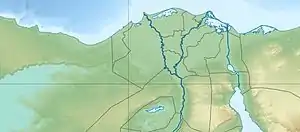Lepsius L
The Lepsius L Pyramid is the remain of a pyramid complex built in Dahshur, approximately 250 m (820 ft) east of the Red Pyramid of pharaoh Sneferu of the Fourth Dynasty.[1] The identity of the pyramid owner is unknown. The site was initially visited by Karl Richard Lepsius during his 1842–45 expedition to Egypt. He provided a brief description and catalogued it as 'Steinpyramide L' in his pyramid list.[2] The site was then excavated by Rainer Stadelmann in 1986.[1]
| Lepsius L | |||||||||||||||||
|---|---|---|---|---|---|---|---|---|---|---|---|---|---|---|---|---|---|
 | |||||||||||||||||
| Unknown, possibly Menkauhor | |||||||||||||||||
| Coordinates | 29°48′39″N 31°12′44″E | ||||||||||||||||
| Ancient name | From a decree of Pepi I presumed to refer to the pyramid: | ||||||||||||||||
| Constructed | Fourth or Fifth Dynasty (possibly) | ||||||||||||||||
| Type | True (now ruined) | ||||||||||||||||
| Material | Limestone | ||||||||||||||||
| Base | ~ 85 m (279 ft; 162 cu)~ 40 m (130 ft; 76 cu) | ||||||||||||||||
 Location within Lower Egypt | |||||||||||||||||
Pyramid complex
Lepsius measured the base of the pyramid as being 85 m (279 ft; 162 cu) square;[3] Stadelmann measured it as being 40 m (130 ft).[4] Lepsius further identified a path leading towards the Red Pyramid which may have been the pyramid's causeway. He also noted the presence of a necropolis adjoining the pyramid's north side.[3] Stadelmann discovered large limestone blocks that are presumed to have been intended for the pyramid's substructure, a mudbrick construction ramp, and the remains of Fourth Dynasty era pottery.[1]
Ownership
Ludwig Borchardt and Stadelmann have ascribed the pyramid to Menkauhor of the Fifth Dynasty of Egypt,[5] though this identification is contested.[6] Borchardt cites a royal decree issued by Pepi I of the Sixth Dynasty that was uncovered in the pyramid town of Sneferu's Red Pyramid and mentions Menkauhor's pyramid as supporting the assignment:[7][8]
Menkauhor is, however, also associated with the Headless Pyramid in Saqqara, another pyramid with contested ownership. This attribution is supported by Jean-Philippe Lauer and Jean Leclant because of the displacement of the causeway of Teti's pyramid;[10][11] Vito Maragioglio and Celeste Rinaldi because of the manner of the construction of the Headless Pyramid's substructure;[11][12] and Zahi Hawass based on the architectural style of the pyramid complex and the extensive use of quality materials typical of the era.[13][14]
Dieter Arnold after examining a re-used block from Amenemhat I's pyramid believed to originate from Menkauhor's pyramid determined that it originated from neither Lepsius XXIX nor Lepsius L and concluded that Menkauhor's pyramid was yet to be uncovered, probably in South Saqqara.[15]
References
- Lehner 2008, p. 101.
- Lepsius 1970, pp. 3, 205, & 207.
- Lepsius 1970, p. 207.
- Stadelmann & Sourouzian 1982, pp. 382–383.
- Stadelmann 2001, p. 354.
- Verner 2001, p. 188.
- Borchardt 1905, pp. 1–3 & 7–8.
- Porter & Moss 1981, p. 876.
- Borchardt 1905, pp. 7–8.
- Verner 2001, pp. 332–333.
- Hawass 2010, p. 157.
- Verner 2001, p. 333.
- Wright 2008.
- Hawass 2010, p. 159.
- Hawass 2010, p. 158.
Sources
- Borchardt, Ludwig (1905). "Ein Königserlaß aus Dahschur". Zeitschrift für Ägyptische Sprache und Altertumskunde (in German). 41–42 (1): 1–42. ISSN 2196-713X.
- Hawass, Zahi (2010). "The excavation of the headless pyramid, Lepsius XXIX". Perspectives on ancient Egypt : studies in honor of Edward Brovarski. Cairo: Supreme Council of Antiquities. pp. 153–170. ISBN 9789777040877.
- Lehner, Mark (2008). The Complete Pyramids. New York: Thames & Hudson. ISBN 978-0-500-28547-3.
- Lepsius, Karl Richard (1970) [1849]. Denkmäler Aus Ägypten und Äthiopen (in German). Osnabrück: Biblio Verlag. OCLC 84318033.
- Porter, Bertha; Moss, Rosalind (1981) [1927]. Málek, Jaromír (ed.). The Topographical Bibliography of Ancient Egyptian Hieroglyphic Texts, Reliefs, and Paintings. Vol. III, 2 (2nd ed.). Oxford: Griffith Institute, Ashmolean Museum. ISBN 0-900416-238.
- Stadelmann, Rainer; Sourouzian, Hourig (1982). "Die Pyramiden des Snofru in Dahschur. Erster Bericht über die Ausgrabungen an der nördlichen Steinpyramide". Mitteilungen des Deutschen Archäologischen Instituts, Abteilung Kairo (in German). 38: 379–393. ISSN 0342-1279.
- Stadelmann, Rainer (2001). "Dahshur". In Redford, Donald B. (ed.). The Oxford Encyclopedia of Ancient Egypt, Volume 1. Oxford: Oxford University Press. pp. 354–356. ISBN 978-0-19-510234-5.
- Verner, Miroslav (2001). The Pyramids: The Mystery, Culture and Science of Egypt's Great Monuments. New York: Grove Press. ISBN 978-0-8021-1703-8.
- Wright, Jonathan (2008). "Eroded pyramid attributed to early pharaoh". Reuters. Retrieved July 2, 2022.